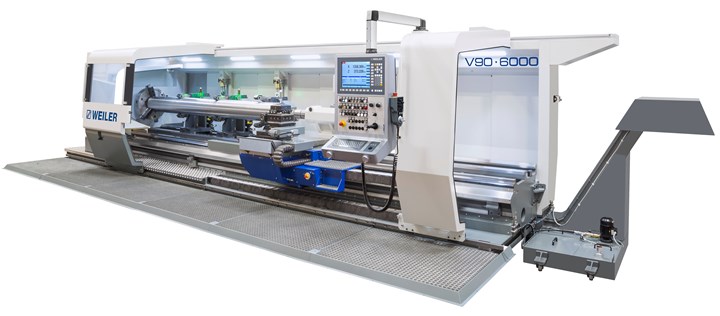Weiler to Debut New Automation Features For Its Lathes
Weiler’s V 110 four-way precision lathe introduces features new to the U.S.
Share







Weiler’s V 110 — similar to but larger than this V 90 model — includes features never before seen in the U.S. Photo Credit: Weiler Werkzeugmaschinen GmbH
Weiler Werkzeugmaschinen GmbH has partnered with Methods Machine Tools to sell and service select products from Weiler’s catalog of precision flat-bed lathes. Two of these products — the E 50HD universal lathe and the larger V 110 model — are on display at Weiler North America’s booth in the South Building, 339053.
The V 110 includes features never seen in the U.S., including four guideways that move the slides, tailstock and steady rest using anti-friction bearings, which provide precise positional accuracy. Walter Nirschl, Weiler’s head of sales, says the V 110 also includes new automation features geared toward a high-production environment. “This configuration makes machining a part much faster,” he says. “Normally we would move the steady rest or tailstock by connecting it to the tool slide, move it to its position and then clamp. But now we can do that completely automatically in the program, saving operation time and setup time and making this model more suitable to a production environment where you have higher quantities of the same pieces on a machine.”
While the E 50 has been previously available to U.S. customers, Nirschl says it is still the perfect demonstration machine for IMTS. “The Weiler E 50HD is a small to mid-sized machine that fits in so many different machine shop environments.”
The E 50, like other Weiler models, utilizes cycle-control technology — conversational control programming performed at the machine that allows machining cycles to be stored and arranged for rapid implementation from drawing to finished workpiece.
Related Content
-
4 Commonly Misapplied CNC Features
Misapplication of these important CNC features will result in wasted time, wasted or duplicated effort and/or wasted material.
-
Quick-Change Tool Heads Reduce Setup on Swiss-Type Turning Centers
This new quick-change tooling system enables shops to get more production from their Swiss turning centers through reduced tool setup time and matches the performance of a solid tool.
-
How to Determine the Currently Active Work Offset Number
Determining the currently active work offset number is practical when the program zero point is changing between workpieces in a production run.












